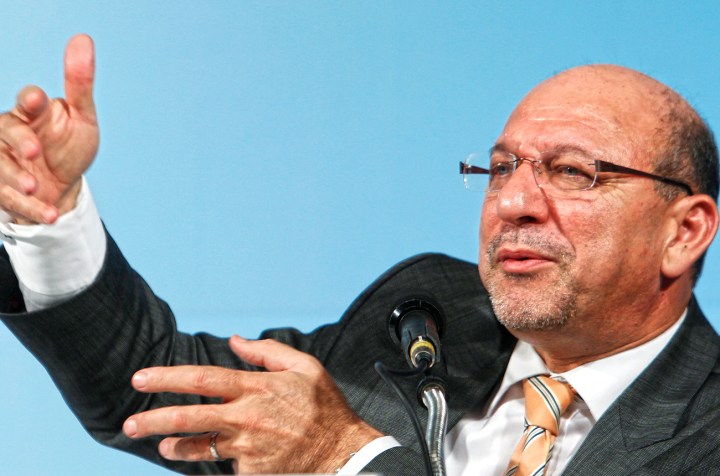South Africa’s current political discourse is littered with “big ideas”. The National Planning Commission's Diagnostic Report is one of them, a powerful and honest document. Pity that no-one will make any effort to communicate it to the people of South Africa – let alone effectively. By CHRIS VICK.
Remember the recent Dinokeng Scenarios, expensive egghead fest which triggered an impressive array of opinion articles for the opinionated? As a result the informed were re-informed — and little else.
Then there was the department of trade and industry’s Industrial Policy, which went through more rewrites than a Mpumalanga matric exam and still hasn’t made a dent in shape of the South African economy.
More recently, there was the National Growth Path, which gave economic planning minister Ebrahim Patel exactly two minutes in the media sunshine — and now has pride of place on every minister’s coffee table.
The latest addition to the line-up is the National Planning Commission (NPC), whose first Diagnostic Report was published last week with less impact on public discourse than the latest episode of “Big Brother”.
One of the few media outlets to give a hearing to national planning minister Trevor Manuel’s report was etv’s Justice Malala, who described Manuel’s first edition as “one of the most depressing documents I have ever read”.
This is probably because the NPC’s diagnosis is the most honest reflection to date on the achievements and shortcomings of our post-apartheid democracy, and contains the germination of some very honest solutions to the challenges we face as a nation. It’s not an easy read, but it’s a very honest one.
The NPC report outlines the very serious obstacles to delivery, in particular, and highlights the potential consequences of government’s current economic “trajectory”. It is a serious intervention into South African thinking, and should be internalised, even if ultimately it is to be rejected, by anyone who is conscious of our own future.
Given its significance, where is the roll-out plan for the latest of these “big ideas”? How are the NPC’s ideas being communicated and sold to South Africans? Where and how is it going to find intellectual traction? What is the commission’s plan to get some serious public participation and commentary around its analysis? How are we to better understand its diagnosis, so that, as citizens, we can help to play a role in choosing and shaping the future?
Your guess is as good as mine.
Manuel told Malala that a series of “provincial hearings” were planned to get discussion going. Some media commentators have hinted at the prospect of a “festival of ideas” further down the line. But unless you still have the “Talk to Trevor” email address from when he was finance minister, it may be hard to find a way to get the NPC conversation rolling.
Maybe it’s useful, at this point, to get nostalgic about how the movement used to communicate big ideas differently.
Let’s start by looking at how the ANC told the world about its first “really big idea” — the Freedom Charter.
Adopted at the Congress of the People in 1955, and formalised by the movement at is national conference in 1956, the Freedom Charter remains the lodestar for the ANC. As we approach the 56th anniversary of the Charter’s drafting (on 26 June), ANC leaders still quote its contents willy-nilly. You may, for example, have heard contemporary ANC Youth League leaders use the following phrase: “The national wealth of our country, the heritage of South Africans, shall be restored to the people; the mineral wealth beneath the soil, the banks and monopoly industry shall be transferred to the ownership of the people as a whole…”
How do today’s leaders know this? How does a document – a national planning charter, in essence – drawn up 56 years ago become so embedded in public discourse?
History tells us there were two phases in getting that big idea into the national psyche:
Crafting the Charter, and
Communicating the Charter.
The crafting process was elaborate, and involved 50,000 freedom volunteers (yes, 50,000), who were sent across the countryside to collect “freedom demands” from the people of South Africa. These were distilled by committees of volunteers into the document that was ultimately adopted at Kliptown and which we today know as the Freedom Charter.
The Congress of the People itself was described by the ANC’s own historians as consisting of “workers, peasants, intellectuals, women, youth and students of all races and colours”. It was probably the ultimate participative process, the think-tank of think-tanks.
The communications process post-Congress of the People was equally elaborate. According to the movement’s own history books, “the Freedom Charter was not adopted immediately by the ANC. The executives of the four organisations of the Congress Alliance met at the beginning of August 1955 and agreed to recommend the adoption of the document by each respective congress. A ‘million signature campaign’ was conceived to popularise the Charter and 10,000 freedom volunteers succeeded in collecting hundreds of thousands of signatures for the Charter.”
Let’s not forget what conditions were like for the ANC in 1955. At the time, the movement was being bitten in the face every day by the apartheid regime and its members were under constant threat of banning, arrest and repression.
The public broadcaster treated the ANC as a terrorist organisation. The print media was reactionary, to say the least. There was no Twitter, no Facebook, no SMSes, no fax machines, no Internet.
The ANC had no state resources at its disposal. It had no advertising spend largesse to throw at media institutions which reported positively on its progress.
All it had were hard-working people committed to bringing about positive change.
Okay, the NPC’s Diagnostic Report is not the Freedom Charter – not by any stretch of the imagination, at least not yet. But like the Dinokeng scenarios, the industrial policy and the new growth path, it is an invaluable contribution to our own understanding of what may be wrong in South Africa. And it provides some extremely useful pointers as to what could be done to correct these wrongs.
We can assume the NPC’s final report will be a fairly definitive outline of South Africa’s options and could, if its authors get it right, become the 21st century’s Freedom Charter, and a new lodestar for the ruling party. Maybe.
But where, we wonder, is the rollout plan? Where are the big ideas around getting “The Big Ideas” discussed? What is the plan for getting South Africans to shape it, embrace it and propagate its contents?
A week after the launch of the commission’s first missive, its first thud into the sands of public discourse, we have to wonder: What impact have the thinkers in the NPC had on the public psyche?
If the commission’s deliberations are important enough to consume the minds of some of South Africa’s best thinkers – Manuel, Cyril Ramaphosa, Bobby Godsell, Vincent Maphai, Miriam Altman, Chris Malikane and Vivienne Taylor, for example – surely it is important enough to merit a decent communications campaign to tell its story to the maximum number of South Africans?
So why is government so bad at selling its big ideas?
Option 1 is that the decision-makers are so far up themselves that they don’t see the need to take public participation seriously. A press conference, a few interviews and the occasional slot on SAfm are probably enough of a public campaign for now. Just leave us alone to think, guys.
Option 2 is that GCIS’ bulk-buying department is still searching for the right “tenderpreneurs” to roll-out the communications campaign. If it’s the same people who blew R36 million on the police commissioner’s national police day, we can expect little more than seriously expensive entertainment and a branded squeegee bottle full of good ideas.
Option 3 is that maybe there are just too many big ideas out there right now, and there is just too much of a mismatch between them for government to deal with. The new growth path takes us down a different route to National Planning Commission’s. The DTI’s industrial policy isn’t exactly aligned to either. So rather than roll out all these ideas and deal with their contradictions, let’s keep the conversation muted.
Option 4 is the most worrying — the ruling party isn’t serious about any of these new policy initiatives. Maybe the view is that the party structures responsible for shaping policy changes within the ANC – the economic transformation committees, the social development transformation committees, and other Luthuli House organs – are where the real thinking happens. And maybe they don’t want that to be contaminated by a decent conversation in government and civil society about future options.
As you consider these options, maybe there’s space for one last look over the shoulder. It’s ironic, with all the recent chattering around Ma Albertina Sisulu’s passing, that some of the key qualities which made the heart and soul of the organisation she represented – the United Democratic Front – have been forgotten. Those qualities were mobilisation and participation, best captured in the UDF propaganda theory which we then called “Poem”: Popularise, Organise, Educate and Mobilise.
What a joy it would be to see a true festival of ideas around all the new thinking that seems to be emerging in the NGP and the NPC. To have communities sit down and hear these new visions for South Africa; to internalize them; to discuss them and to hear people’s comments. And to then have the machinery in place – the new age freedom volunteers – who distil, process and package those ideas into acceptable forms. So that they shape their future together with those intellectuals – on community radio, on Facebook and Twitter, in newspapers and in conversations in bars.
Sadly, at a time when government wants so hard to try to communicate, the true notion of propaganda – media which focuses on popularisation, organisation, education and mobilisation – is absent.
So the best you can hope for is an advert with the mayor’s photo in your local newspaper. Or a tedious 5,000-word advertorial from the minister of public services. Or some hack’s hackneyed delivery statistics in a government magazine. Or The New Age.
So you don’t popularise anything. You don’t organise anybody. You don’t educate anyone. And you mobilise nothing. DM
Chris Vick is a hopeless nostalgic who was involved in UDF and ANC propaganda structures when the UDF and the ANC were still banned. He now runs Black, a communications consultancy.


















 Become an Insider
Become an Insider